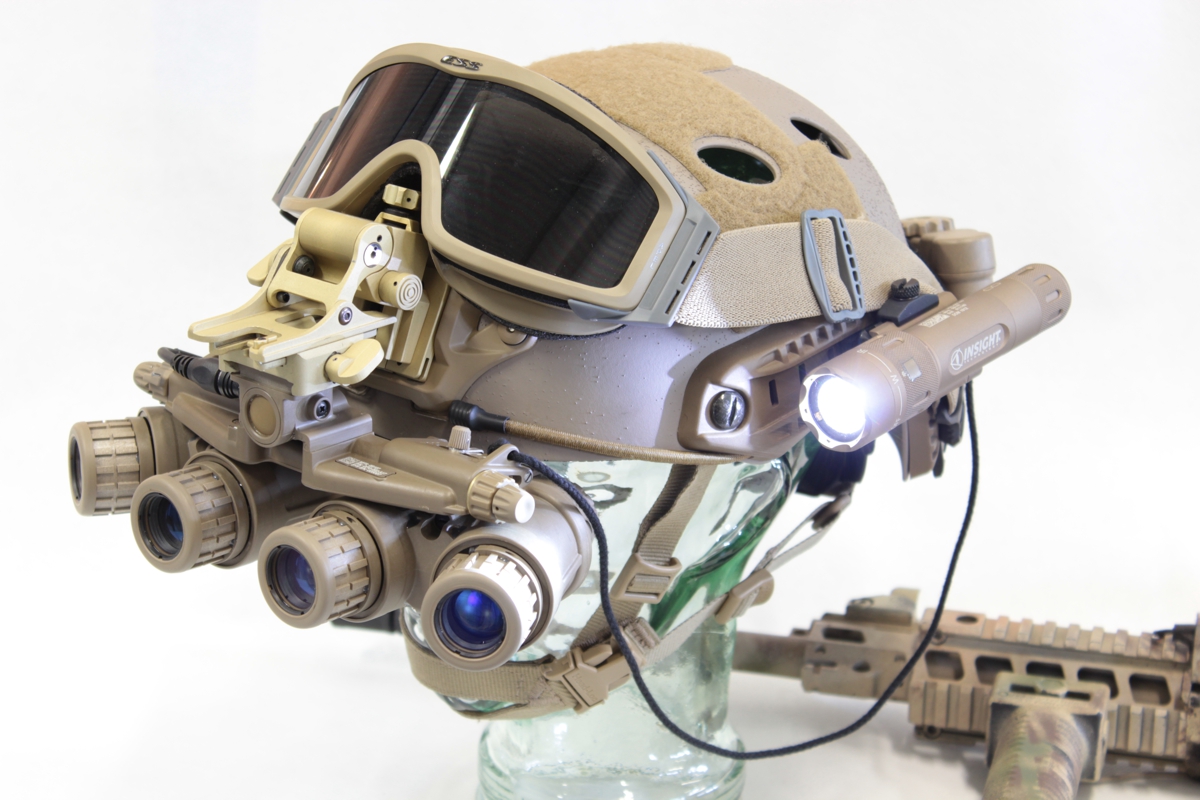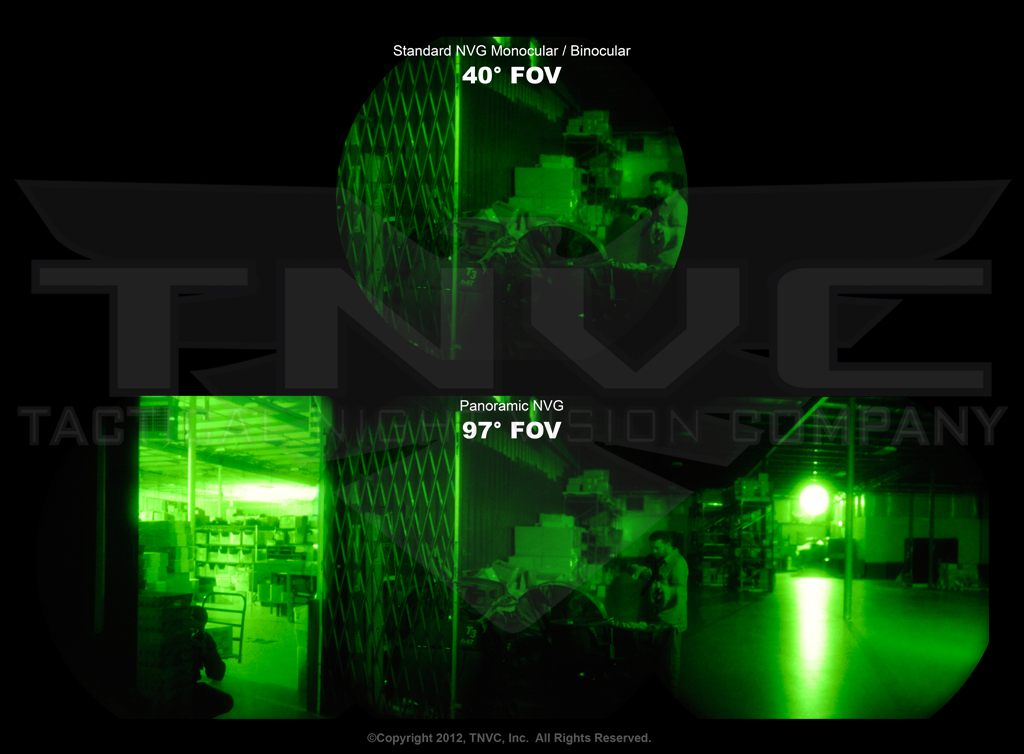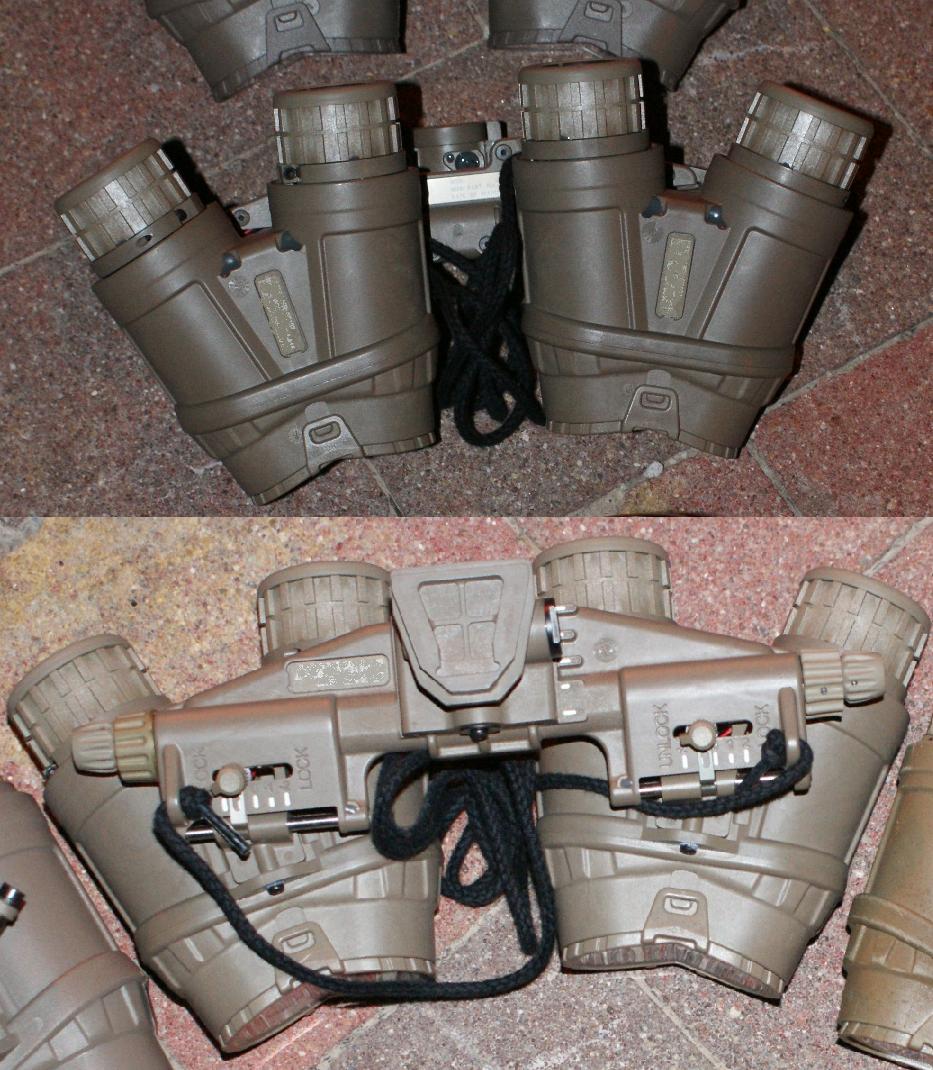Hol Dir den wöchentlichen SPARTANAT-Newsletter.
Dein Bonus: das gratis E-Book von SPARTANAT.

REVIEW: L-3 Ground Panoramic Night Vision Goggle
Mit den Ground Panoramic Night Vision Goggles (GPNVG) von L-3 erhalten Sie fast das gleiche Sichtfeld wie bei Tag, jedoch in grün bei Nacht - ein deutlicher Vorteil in engen Räumen. Durch die Fusion von vier Bildverstärkerröhren in zwei Flügel wird das einzigartige Sichtfeld von 97° erreicht. Dieses innovative Nachtsichtgerät eignet sich besonders gut für Piloten und ermöglicht eine schnellere Zielerfassung in beengten Umgebungen. Erhältlich ab 30.000 € für Behörden.
Mit annähernd gleichem Blickfeld wie am Tag nur in Grün bei Nacht zu sehen ist ein markanter Vorteil, vor allem in beengten Räumen. Diesen Vorteil erreicht man mit den Ground Panoramic Night Vision Goggles (GPNVG) von L-3. Wir konnten dieses State of Art Nachtsichtgerät testen und berichten euch von unseren Erfahrungen. (Alle Bilder zum Vergrößern anklickbar).
 Ein 97° Sehfeld ist im ersten Moment schwer zu beschreiben, wenn man durch das GPNVG18 blickt. Das obere Bild von TNVC bringt es aber gut auf den Punkt. Mit normalen Geräten hat man ein Sehfeld von ~40°, was für freie Flächen und große Entfernungen ausreichend ist. Mit zwei Röhren wie beim PVS15 ist es sogar ziemlich gut. Aber im beengten Raum – wie in Laufgräben, in Häusern usw. –ist ein normales Nachtsichtgerät eher eine Behinderung als eine Verbesserung. Der Röhrenblick und die unterschiedlichen nötigen Fokussierungen irritieren extrem. Aus diesem Grund wurde das GPNVG18 entwickelt. Genau in diesen beschriebenen Einsatzorten spielt es seine Vorteile komplett aus, auch wenn es bereits seit drei Jahren am Markt ist und ursprünglich für Piloten entwickelt wurde. Um dieses Sehfeld zu erreichen wurden vier Bildverstärkerröhren verwendet, wobei jeweils zu zwei in ein Okular zusammengeführt wurden. Dadurch ergibt sich die einzigartige Form des GPNVG18, das den Träger hochgeklappt wie einen Hirsch und heruntergeklappt wie ein Insekt aussehen lässt.
Ein 97° Sehfeld ist im ersten Moment schwer zu beschreiben, wenn man durch das GPNVG18 blickt. Das obere Bild von TNVC bringt es aber gut auf den Punkt. Mit normalen Geräten hat man ein Sehfeld von ~40°, was für freie Flächen und große Entfernungen ausreichend ist. Mit zwei Röhren wie beim PVS15 ist es sogar ziemlich gut. Aber im beengten Raum – wie in Laufgräben, in Häusern usw. –ist ein normales Nachtsichtgerät eher eine Behinderung als eine Verbesserung. Der Röhrenblick und die unterschiedlichen nötigen Fokussierungen irritieren extrem. Aus diesem Grund wurde das GPNVG18 entwickelt. Genau in diesen beschriebenen Einsatzorten spielt es seine Vorteile komplett aus, auch wenn es bereits seit drei Jahren am Markt ist und ursprünglich für Piloten entwickelt wurde. Um dieses Sehfeld zu erreichen wurden vier Bildverstärkerröhren verwendet, wobei jeweils zu zwei in ein Okular zusammengeführt wurden. Dadurch ergibt sich die einzigartige Form des GPNVG18, das den Träger hochgeklappt wie einen Hirsch und heruntergeklappt wie ein Insekt aussehen lässt.
 Jeweils zwei Röhren (Gen3 18mm MX-10160 Lichtverstärkerröhren) sind in einem Gehäuse verbaut, die zwei Gehäuse sind an einer Brücke justierbar befestigt. Durch Drehen an den Knöpfen rechts und link verschiebt man die Optikgruppen so, dass sich ein durchgehendes Bild vor den Augen ergibt. In der Mitte der Brücke ist die Halterung für den NVG-Arm angebracht. Es gibt zwei Ausführungen: ANVIS und BNVIS (Dovetail). Bei diesem Gerät wurde auf eine manuelle Dioptereinstellung beim Okular verzichtet. Stattdessen werden hinter das Okular spezielle Ausgleichsscheiben geklemmt von +0.5 bis -2.5 Dioptrien. Diese Einstellung sollte natürlich vor der Verwendung im Feld gemacht werden.
Jeweils zwei Röhren (Gen3 18mm MX-10160 Lichtverstärkerröhren) sind in einem Gehäuse verbaut, die zwei Gehäuse sind an einer Brücke justierbar befestigt. Durch Drehen an den Knöpfen rechts und link verschiebt man die Optikgruppen so, dass sich ein durchgehendes Bild vor den Augen ergibt. In der Mitte der Brücke ist die Halterung für den NVG-Arm angebracht. Es gibt zwei Ausführungen: ANVIS und BNVIS (Dovetail). Bei diesem Gerät wurde auf eine manuelle Dioptereinstellung beim Okular verzichtet. Stattdessen werden hinter das Okular spezielle Ausgleichsscheiben geklemmt von +0.5 bis -2.5 Dioptrien. Diese Einstellung sollte natürlich vor der Verwendung im Feld gemacht werden.
Betrieben wird das GPNVG18 über vier 3V CR123A Batterien die in einem externen Batteriebehälter untergebracht sind. Die Verbindung von GPNVG18 und Batterien erfolgt über ein Standard ANVIS-Kabel, die Betriebszeit beträgt ungefähr 30 Stunden. Mit dem Druckknopf in der Mitte der Brücke wird das Gerät ein und ausgeschalten und es verfügt über keinen automatischen Abschaltmechanismus, wenn es hochgeklappt wird.
 Zum Fokusieren muss jede Linse einzeln gedreht werden. Vor den Linsen ist ein Schutzglas angebracht, welches problemlos und schnell ausgetauscht werden kann. Die Masse des Geräts beläuft sich auf ~765g wodurch ein Gegengewicht von knapp 500g notwendig wird, um es über längere Zeiten bequem am Helm zu tragen. Hinten am Helm ist die Batteriebox für das GPNVG montiert, von der es zwei Ausführungen gibt.
Zum Fokusieren muss jede Linse einzeln gedreht werden. Vor den Linsen ist ein Schutzglas angebracht, welches problemlos und schnell ausgetauscht werden kann. Die Masse des Geräts beläuft sich auf ~765g wodurch ein Gegengewicht von knapp 500g notwendig wird, um es über längere Zeiten bequem am Helm zu tragen. Hinten am Helm ist die Batteriebox für das GPNVG montiert, von der es zwei Ausführungen gibt.
FAZIT: Eine neue Generation von tragbaren Nachtsichtgeräten ist mit dem GPNVG18 eingeläutet worden. Durch das große Blickfeld von 97° ist nun die Bewegung in beengten Räumen mit einem Nachtsichtgerät kein Problem mehr, Ziele können viel schneller aufgefasst werden. Das Gerät ist sowohl für z.B. Piloten oder auch Bootsführer – Leute die sich im Raum orientieren müssen – ein großer Vorteil wie es auch im Close Quarter Battle unvergleichlich neben normalen Nachtsichtgeräten ist.
Erhältlich NUR FÜR BEHÖRDEN ab einem Preis von 30.000 €.
HIER geht es zum Vergleich mit dem FMA Dummy vom GPNVG
HIER geht es zum Vergleich mit dem SATC Spartan Dummy vom GPNVG
SPARTANAT ist das Online-Magazin für Military News, Tactical Life, Gear & Reviews.
Schickt uns eure News: [email protected]
Werbung
Hol Dir den wöchentlichen SPARTANAT-Newsletter.
Dein Bonus: das gratis E-Book von SPARTANAT.


